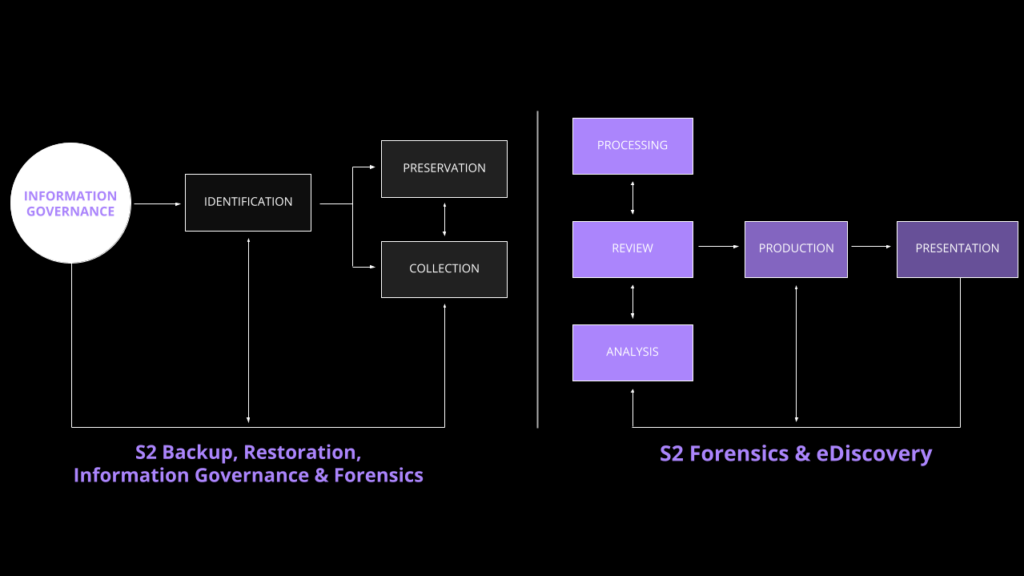What is eDiscovery?
Discovery is the phase in litigation wherein the parties exchange relevant information, along with any pertinent records, regarding the case. Parties are legally required to exchange any pertinent, non privileged information with each other. This is required in order to ensure that both sides have access to relevant evidence and have an equal setting on which to advocate their respective positions.
eDiscovery is basically evidence that might be stored on a digital or electronic medium. eDiscovery can consist of anything which can be stored digitally or electronically – whether it be emails, text messages or documents stored on a computer. This is something we are familiar with from our daily lives as well – just think of how many text messages and photographs your phone has stored within it.

eDiscovery also consists of “metadata” which provides information about the data itself such as the author of the date, the date/time when the date was created, who it was sent to etc. Therefore, as you can see eDiscovery can be quite complex because of its electronic nature and also because of its copious amount. The process, as well the technologies used in extracting data, can be very complex because of the massive amounts of electronically stored data. As with non-electronic discovery, eDiscovery is required to be produced in response to a lawsuit or investigation. After relevant data is identified as being pertinent to a lawsuit or investigation, the party in possession of it cannot delete or tamper it.
What types of businesses employ eDiscovery?
eDiscovery is particularly relevant in today’s world, where most documentation, or even most communication for that matter, is digital or electronic. Since parties are required to exchange discovery even when it is stored electronically, it becomes important to adequately preserve, and thereafter obtain it. A logical question that follows is when does the duty to store such digital information begin? Are people under a perpetual obligation to store all their electronic documentation and communication? The short answer is No. Such a duty only comes into existence when a lawsuit is foreseeable. Therefore, the duty to store relevant data only comes into existence when a party knows of or has a reasonable anticipation of future litigation. Upon the commencement of such duty it is not allowed, and actually legally actionable, to tamper with or delete the data.
Even apart from such a duty many companies store copious amounts of data as part of their day to day business operations e.g. hospitals, banks etc. Furthermore, many businesses are legally obligated to store certain data. Therefore eDiscovery is a widely encompassing field and is employed by various businesses across various industries. Apart from businesses, eDiscovery is relevant to individuals as well. For instance a defendant in a criminal action might have sent out some text message which might incriminate him, or the plaintiff in a personal injury action might have taken some photographs of the scene of the accident from his phone. All these situations fall under the umbrella of eDiscovery.
Apart from simply complying with discovery requests served on you, eDiscovery can also be utilized by you to obtain discovery from a third party. A third party might be in possession of discovery materials which could be helpful in furthering your position in an investigation or litigation.
What is the importance of eDiscovery and finding a trustworthy eDiscovery provider?
The importance of eDiscovery is underscored by the legal duty to preserve and exchange it in the face of impending litigation. Failure to preserve the relevant eDiscovery data can have adverse consequences for you, whether you are the plaintiff or defendant. Such legal consequences can range from sanctions being levied against you, to the Jury being instructed that you have engaged in destruction of pertinent evidence, or even jail time.

Because of the adverse consequences which could result from eDiscovery being lost or tampered with it is very important to work with a trustworthy eDiscovery provider. To add to the legal dynamic it must also be kept in mind that much of the information stored electronically could be of a very private or sensitive nature and therefore working with an eDiscovery provider who will respect the sensitivity of such data is very important. A reliable eDiscovery provider will ensure that your data is not jeopardized by making sure it doesn’t fall into the wrong hands. A trustworthy eDiscovery provider will also be able to properly collect, prepare and produce the pertinent electronically stored data, or information. Therefore companies and parties would be advised to work with a reliable and experienced eDiscovery provider who can handle all of its aspects.
eDiscovery stats
There is no doubt that eDiscovery is an important and growing sector. The importance of eDiscovery is underscored by the growing use of digital devices as well as the work from home models with more focus on digital communication, which many companies have adopted in the wake of the COVID 19 pandemic.
In today’s day and age more than 90 percent of all information is now communicated and stored electronically. Because of such digital growth the eDiscovery sector is growing rapidly and not showing any signs of slowing down. The eDiscovery market is expected to grow in size from USD 9.3 billion in 2020 to USD 12.9 billion by 2025. This is further emphasized by the fact that the majority of Fortune 1000 companies spend between $5-$10 million on eDiscovery each year.
What is the EDRM model/diagram, and what does it represent?
EDRM, Electronic Discovery Reference Model, is a model which serves as guidance for gathering electronic data. The Model poses 9 different stages which outline what activities should be undertaken when gathering electronic data. The 9 stages are as follows:
- Information Governance: Each company should have specific data management guidelines which comply with the law and any applicable regulations to manage its data e.g. a company might have a policy in place which says to keep all emails in place for 5 years.
- Identification: Identify the individuals who have access to the pertinent data.
- Preservation: Make sure it is known company wide that the relevant data needs to be preserved.
- Collection: Collect the relevant data.
- Process: Upload the relevant date into the eDiscovery tool.
- Review: Document reviewers such as attorneys will review all documents to determine their relevance.
- Analysis: Develop a better understanding of the data in question to uncover trends and patterns.
- Production: Producing the relevant documents.
- Presentation: The produced documents should be organized into presentable format.

Is eDiscovery the same as forensics?
While there are similarities between eDiscovery and digital forensics there are important differences as well. Both areas are related to the preservation and use of digital data, but with key differences. eDiscovery can be defined as the process of collecting, preparing, reviewing and producing electronic documents, whereas digital forensics involves the use of a forensic expert to protect data integrity and to bring forth the store data.
An important difference is regarding the review and analysis of the collected data. eDiscovery firms will usually not analyze the data they collect, rather they will just present it to the attorney working on the case for review and analysis. It will be then up to the attorney to review, analyze and interpret the data. Whereas the role of a forensics expert will be different and more proactive when it comes to reviewing and analyzing the data. A forensics expert will not only assist the legal team in producing the pertinent evidence, but will also partner with attorneys to pinpoint keywords related to the case, and then cross-reference those keywords against the collected data. Therefore, unlike digital forensics, eDiscovery is not a tool for analyzing or investigating, rather it is used simply to gather and organize information.
Is eDiscovery a proactive or reactive solution?
(it can be both)
eDiscovery can be both proactive and reactive. Probably the majority of companies only start thinking seriously about eDiscovery when faced with discovery requests to exchange pertinent data, and that is when eDiscovery is applied in a reactive mode. eDiscovery can serve as a reactive solution when data needs to be gathered and produced in response to litigation or an investigation. In such a context an eDiscovery firm will be utilized to gather, produce and present the data which will be helpful in prosecuting or defending litigation to protect your interests.
However, some companies might take on a proactive approach and have procedures set in place to retrieve data in case, in the future, there is any litigation or investigation which might require them to exchange that pertinent data. Companies can have proactive eDiscovery procedures in place to reduce litigation risks by having an Information Management program which provides guidance to quickly identify and retrieve relevant information, when it will be needed. Also, to be proactive, companies can have in place standard eDiscovery practices which outline who has the pertinent data, where they have it, how it can be produced etc.
What is Info Governance (Info Gov), and how does it relate to eDiscovery?
(can use verbiage from Legacy Data Liability Reduction document)
Information Governance (Info Gov) is the first stage of the Electronic Discovery Reference Model, and is simply a tool to mitigate risks and expenses should you have to partake in eDiscovery. Info Gov is basically a proactive approach to eDiscovery, under which a company will have guidelines to identify and retain data which might be useful in case of future litigation or investigation. It outlines policies by which information should be controlled and enforces those policies across the company.

By having such guidelines, companies can ensure that relevant data is stored and easily accessible in case it might be needed at a future time. Another point of having such guidelines is to reduce costs of storing excess or unnecessary data which would not be relevant. If you have been able to identify the pertinent data, you can quickly access it once litigation arises, thereby saving time, energy and costs.
